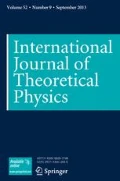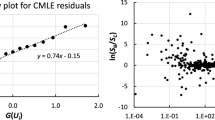Abstract
Rotating wave approximation (RWA) has been used to evaluate the transition probability and solve the Schrödinger equation approximately in quantum optics. Examples include the invalidity of the traditional adiabatic condition for the adiabaticity invoking a two-level coupled system near resonance. Here, using a two-state system driven by an oscillatory force, we derive the exact transition probability by solving the Schrödinger equation analytically for a general wave function. Our results reveal that the application of the RWA may lead to false conclusions on the transition probability for the near resonance with weak coupling, especially when the coupling strength is about a half of the transition frequency. We also investigate conditions for which RWA may work or fail.


Similar content being viewed by others
References
Satanin, A.M., Denisenko, M.V., Ashhab, S., Nori, F.: Phys. Rev. B 85, 184524 (2012)
Jaynes, E.T., Cummings, F.W.: Proc. IEEE 51, 89 (1963)
Larson, J.: Phys. Rev. Lett. 108, 033601 (2012)
Greentree, A.D., Koch, J., Larson, J.: J. Phys. B 46, 220201 (2013)
Larson, J.: Phys. Scr. T153, 014040 (2013)
Meystre, P., Sargent III, M.: Elements of Quantum Optics. Springer, Berlin (1991)
Griffiths, D.J.: Introduction to Quantum Mechanics, 2nd edn. Prentice Hall (2005)
Grifoni, M., Hänggi, P.: Phys. Rep. 304, 229–354 (1998)
Wang, X.G., Sun, C.P.: Acta physica Sinica 5, 881–889 (1996)
Gerry, C.C., Knight, P.L.: Introductory Quantum Optics. Cambridge University Press, New York (2005)
Amin, M.H.S.: Phys. Rev. Lett. 102, 220401 (2009)
Sun, Z., Ma, J., Wang, X., Nori, F.: Phys. Rev. A 86, 012107 (2012)
Silveri, M.P., Kumar, K.S., Li, J., Tuorila, J., Vepsäl äinen, A., Thuneberg, E. V., Paraoanu, G. S.: New J. Phys. 17, 043058 (2015)
Boyd, J.K.: J. Math. Phys. 41, 4330 (2000)
Xie, Q., Hai, W.: Phys. Rev. A 82, 032117 (2010)
Ashhab, S., Johansson, J.R., Zagoskin, A.M., Nori, F.: Phys. Rev. A 75, 063414 (2007)
Angelo, R.M., Wreszinski, W.F.: Phys. Rev. A 72, 034105 (2005)
Irish, E.K., Gea-Banacloche, J., Martin, I., Schwab, K.C.: Phys. Rev. B 72, 195410 (2005)
Ford, G. W., O’Connell, R.F.: Physica A 243, 377–381 (1997)
Fujii, K.: ArXiv:quant-ph/1301.3585v3 (2014)
Ashhab, S., Johansson, J.R., Nori, F.: Phys. Rev. A 74, 052330 (2006)
Shevchenko, S.N., Ashhab, S.S., Nori, F.: Phys. Rep. 492, 1–30 (2010)
Satanin, A.M., Denisenko, M.V., Gelman, A.I., Nori, F.: Phys. Rev. B 90, 104516 (2014)
Ashhab, S., Nori, F.: Phys. Rev. A 81, 042311 (2010)
Cao, X., You, J.Q., Zheng, H., Nori, F.: Phys. Rev. A 82, 022119 (2010)
Cao, X., You, J. Q., Zheng, H., Nori, F.: New J. Phys. 13, 073002 (2011)
Cao, X., Ai, Q., Sun, C.P., Nori, F.: Phys. Lett. A 376, 349–357 (2012)
Garziano, L., Stassi, R., Macrì, V., Kockum, A.F., Savasta, S., Nori, F.: Phys. Rev. A 92, 063830 (2015)
Cirio, M., Liberato, S.D., Lambert, N., Nori, F.: Phys. Rev. Lett. 116, 113601 (2016)
Garziano, L., Macrì, V., Stassi, R., Stefano, O.D., Nori, F., Savasta, S.: Phys. Rev. Lett. 117, 043601 (2016)
Stassi, R., Savasta, S., Garziano, L., Spagnolo, B., Nori, F.: New J. Phys. 18, 123005 (2016)
Stefano, O.D., Stassi, R., Garziano, L., Kockum, A.F., Savasta, S., Nori, F.: New J. Phys. 19, 053010 (2017)
Kockum, A.F., Miranowicz, A., Macrì, V., Savasta, S., Nori, F.: Phys. Rev. A 95, 063849 (2017)
Kockum, A.F., MacRì, V., Garziano, L., Savasta, S., Nori, F: Sci. Rep. 7, 5313 (2017)
Chen, Z., Wang, Y., Li, T., Tian, L., Qiu, Y., Inomata, K., Yoshihara, F., Han, S., Nori, F., Tsai, J. S., You, J. Q.: Phys. Rev. A 96, 012325 (2017)
Cirio, M., Debnath, K., Lambert, N., Nori, F.: Phys. Rev. Lett. 119, 053601 (2017)
Stassi, R., Macrì, V., Kockum, A.F., Stefano, O.D., Miranowicz, A., Savasta, S., Nori, F.: Phys. Rev. A 96, 023818 (2017)
Acknowledgments
S. Li thanks the stimulating discussion with Prof. Z. Sullivan at the Physics Department of Illinois Institute of Technology. D. Li thanks Man-Hong Yung and Yanjun Hao for their discussion. All authors thank the reviewer for his useful suggestions. This work was supported by NSFC (Grant No. 10875061) and Tsinghua National Laboratory for Information Science and Technology.
Author information
Authors and Affiliations
Corresponding author
Appendices
Appendix A: the Wave Function of the System Obtained with the RWA
Fujii considered a two-state system in [20],
With the RWA, H in (A2) is reduced to (see Eq. (9) in [20])
We consider the Schrödinger equation
Let
Substituting (A5) into (A4), we obtain the following Schrödinger equation (see Eq. (12) in [20])
Let \(\displaystyle r=\frac {\Delta -\omega }{2}\). The exact solution of the Schrödinger equation in (A6) for r = 0 (i.e. Δ = ω) was discussed in [20]. We next solve the Schrö dinger equation in (A6) for r≠ 0 (i.e. Δ≠ω).
Let \(\displaystyle \mathcal {A}=g\sigma _{x}-r\sigma _{z}\). We rewrite (A6) as follows
From (A7) we obtain
A calculation yields
where \(\displaystyle {\Pi } =\sqrt {g^{2}+r^{2}}\). When r = 0, then π = g. The detail for the derivation of \(e^{-i\mathcal {A}t}\) is given in B. Note that Φ(0) = ψ(0) = |0〉. From (A8, A9), we obtain
From (A10, A5), after omitting the phase factor ei(ωt + ϕ)/2, we obtain
Appendix B: Calculation of \(e^{\protect \lambda \mathcal {A}}\)
Note that \(\displaystyle e^{\lambda \mathcal {A}}={\sum }_{k = 0}^{\infty }\frac { \lambda ^{k}}{k!}\mathcal {A}^{k}\), where \(\displaystyle \mathcal {A}^{0}=I_{2}\) .
Taking \(\displaystyle {\Pi } =\sqrt {g^{2}+r^{2}}\) leads to \(\displaystyle \mathcal {A}^{2}={\Pi }^{2}I_{2}\). A calculation yields
and
Then,
Appendix C: the Numerical Solution
Let a(t) = u(t) + iv(t) and b(t) = x(t) + iy(t), where u(0) = 1 and v(0) = x(0) = y(0) = 0. From (15) we obtain the first-order real linear system
where \(\dot {x}\) denotes \(\frac {dx}{dt}\) and \(\displaystyle A=\left (\begin {array}{cc} -\beta (t) & \frac {\Omega (t)}{2} \\ \frac {\Omega (t)}{2} & \beta (t) \end {array} \right ) \). Let \(\displaystyle X=\left (\begin {array}{c} x \\ v \end {array} \right ) \) and \(\displaystyle Y=\left (\begin {array}{c} u \\ y \end {array} \right ) \), then the first-order real linear system becomes a simpler form \(\dot {X}=AY,\dot {Y}=-AX\). We then apply a forth-order Runge-Kutta scheme to the linear system
where A n is the matrix A evaluated at t n = nΔt, An+ 1/2 is the matrix A evaluated at \(\displaystyle t_{n+\frac {1}{2} }=(n + 1/2){\Delta } t\), and An+ 1 is the matrix A evaluated at tn+ 1 = (n + 1)Δt.
Rights and permissions
About this article
Cite this article
Li, D., Zhao, M. & Li, S. On the Transition Probability for the Near or Exact Resonance with the RWA. Int J Theor Phys 57, 1391–1403 (2018). https://doi.org/10.1007/s10773-018-3667-9
Received:
Accepted:
Published:
Issue Date:
DOI: https://doi.org/10.1007/s10773-018-3667-9




